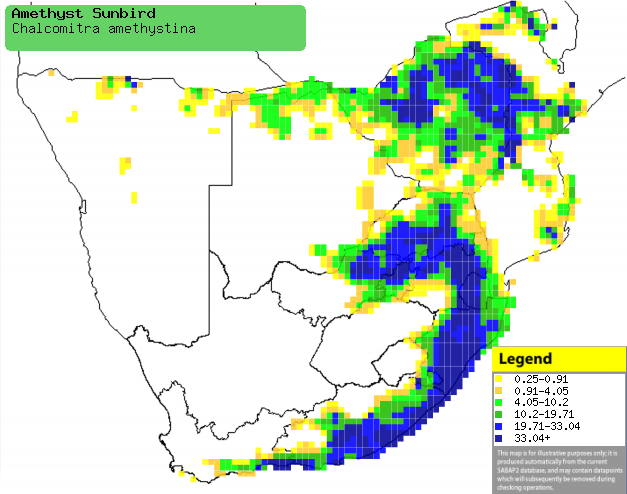|
Chalcomitra amethystina (Amethyst
sunbird, Black sunbird)
[= Nectarinia amethystina]
Swartsuikerbekkie [Afrikaans]; Ingcungcu (generic term for
sunbird) [Xhosa]; Kalyambya (generic term for sunbird) [Kwangali]; Dzonya,
Tsodzo (both are generic names for sunbird) [Shona]; Nwapyopyamhanya (generic
term for sunbird) [Tsonga]; Senwabolôpe, Talêtalê (generic terms for
sunbirds) [Tswana]; amethist-honingzuiger [Dutch]; Souimanga améthyste
[French]; Amethyst-glanzköpfchen [German]; Beija-flor-preto [Portuguese]
Life
> Eukaryotes >
Opisthokonta
> Metazoa (animals) >
Bilateria >
Deuterostomia > Chordata >
Craniata > Vertebrata (vertebrates) > Gnathostomata (jawed
vertebrates) > Teleostomi (teleost fish) > Osteichthyes (bony fish) > Class:
Sarcopterygii (lobe-finned
fish) > Stegocephalia (terrestrial
vertebrates) > Tetrapoda
(four-legged vertebrates) > Reptiliomorpha > Amniota >
Reptilia (reptiles) >
Romeriida > Diapsida > Archosauromorpha > Archosauria >
Dinosauria
(dinosaurs) > Saurischia > Theropoda (bipedal predatory dinosaurs) >
Coelurosauria > Maniraptora > Aves
(birds) >
Order: Passeriformes > Family: Nectariniidae
Distribution and habitat
Mainly occurs in Africa south of the equator, from Kenya
and Tanzania through southern DRC and Zambia to southern Africa. Here it is
fairly common across Zimbabwe, northern and south-eastern Mozambique and South
Africa from Limpopo Province and Gauteng to KwaZulu-Natal, extending down the
coast to Cape Agulhas. It is also has scattered populations in northern Namibia
(including the Caprivi Strip) and northern as well as south-eastern Botswana. It
generally favours in coastal evergreen forest and mature valley bushveld, but it
may also move into drier, more open woodland. It sometimes goes out of its way
to visit a large clump of nectar-bearing plants, such as Aloe.
|
 |
|
Distribution of Amethyst sunbird in southern Africa,
based on statistical smoothing of the records from first SA Bird Atlas
Project (©
Animal Demography unit, University of
Cape Town; smoothing by Birgit Erni and Francesca Little). Colours range
from dark blue (most common) through to yellow (least common).
See here for the latest distribution
from the SABAP2. |
Brood parasites
It has been recorded as host of the
Green-backed honeybird
and Klaas's cuckoo.
Food
It eats nectar supplemented with insects, foraging wherever
nectar is available. It often hawks flying insects from the trees or bushes,
also gleaning them from leaves and branches. Nectar is obtained either from
flowers or from garden feeders, which it uses readily (note that in feeding
experiments it was found to prefer sucrose rather than sugar). The following
food items have been recorded in its diet:
- Nectar
- Aloe
- Strelitzia
- Salvia
- Cestrum
- Bauhinia
- Eucalyptus
- Hibiscus
- Protea
- Eryrthrina (coral-trees)
- Knipholia (torch lilies)
- Schotia (boer-beans)
- Leonotis (wild dagga)
- mistletoe (Loranthaceae)
- Tecoma capensis (Cape honeysuckle)
- Callistemon viminalis (Australian bottlebrush)
- Greyia sutherlandii (Natal bottlebrush)
- Leucospermum (pincushion)
- Combretum (bushwillows)
- Crotalaria capensis (Cape rattle pod)
- Halleria lucida (Tree-fuchsia)
- Dalbergia nitidula (Glossy flat-bean)
- Cordyla africana (Wild mango)
- Faurea speciosa (Broad-leaved beechwood)
- Baikiaea plurijuga (Zambezi teak)
- sucrose or sugar taken from garden feeders
- Flying insects
-
Spiders
Breeding
- The nest (see image below) is built solely by the female, consisting of an
oval-shaped structure built of lichen, grass, stalks and bark cemented with
spider web. The 3.5 - 5.5 cm entrance is placed on the side, and the inside
is lined with soft plant down and feathers. It is attached strongly to a
drooping branch of a tree, bush or creeper usually 2-6 metres above ground.
- Egg-laying season is year round, peaking from September-November in
Zimbabwe and October-February in South Africa.
- It lays 1-3 eggs, which are incubated solely by the female for 13-18
days.
- The chicks are fed mainly by the female, leaving the nest after about
14-18 days, becoming independent after at least 1 week.
Threats
Not threatened, in fact its range has increased recently
due to the spread of wooded gardens.
References
-
Hockey PAR, Dean WRJ and Ryan PG 2005. Roberts
- Birds of southern Africa, VIIth ed. The Trustees of the John Voelcker
Bird Book Fund, Cape Town.
|
